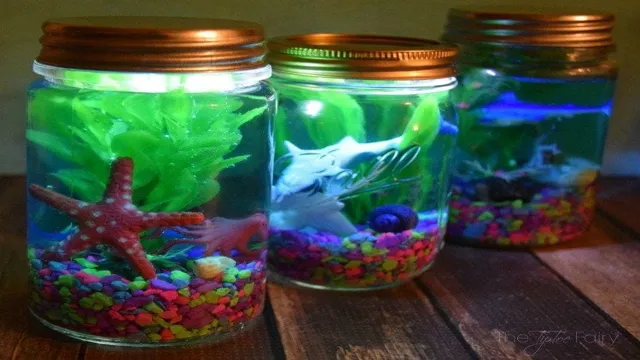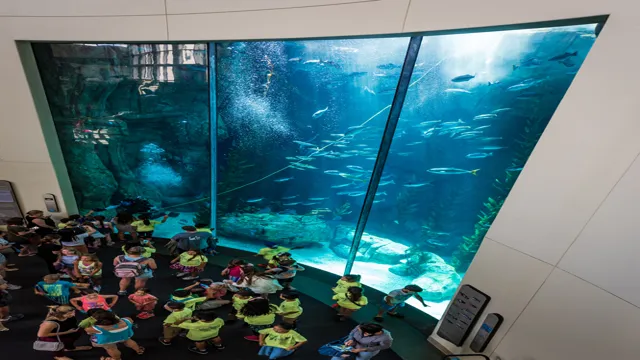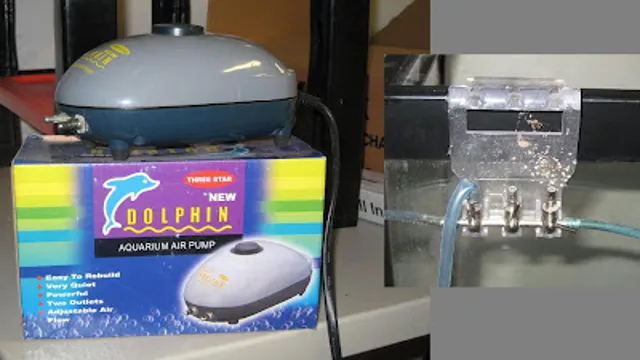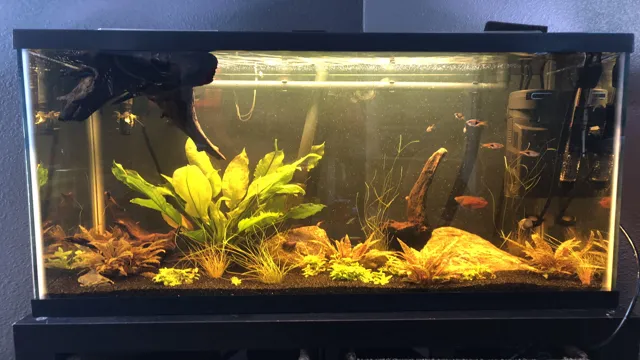If you’re looking for a unique and creative way to bring some underwater wonder into your space, then creating an aquarium in a jar might just be the perfect project for you! Not only is it an easy and affordable way to bring the beauty of the ocean into your home or office, but it also offers an opportunity to learn about aquatic life and the responsibility of caring for living organisms. In this blog post, we’ll explore the steps and tips necessary to create an aquarium in a jar that is both functional and visually appealing. So grab your jar and let’s dive into the world of aquascaping!
Materials Needed
If you’re interested in creating a small aquarium in a jar, there are a few materials you’ll need to get started. First, you’ll need a glass jar with a lid, ideally one that’s at least a gallon in size. You’ll also need some rocks or sand to serve as a substrate for your aquarium, as well as some aquatic plants to provide oxygen for your fish.
Depending on the size of your jar, you may choose to get a small filter to help keep the water clean, as well as a heater to maintain an appropriate temperature. Finally, you’ll need some fish, but be sure to do your research and choose fish that are appropriate for the size of your aquarium and can live comfortably in a jar environment. With these materials in hand, you can easily create a beautiful and unique aquarium to enjoy in your home or office.
1. A clear jar or container
If you’re thinking of starting a DIY project, one of the materials you will need is a clear jar or container. These can be found in various sizes and shapes and are perfect for storing and displaying items. Whether you’re making a terrarium, a candle holder, or a personalized gift for someone, a clear jar is a versatile item that can be used for countless projects.
You can find them at your local craft store or online retailer. Clear jars allow you to see the contents inside, which makes them great for displaying decorative items, plants, or colored sand. They’re also easy to decorate by adding ribbons, stickers, or other embellishments.
With a clear jar, you have endless possibilities to create a unique and personalized project. So, grab your clear jar and let your imagination run wild!
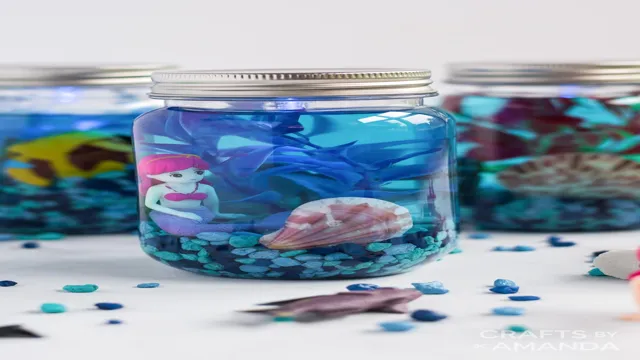
2. Gravel or sand for bottom
When it comes to setting up your aquarium, one question that will arise is whether to use gravel or sand for the bottom. Both materials have their advantages and disadvantages, so it really depends on what you prefer. Gravel is a popular choice because it is easy to clean and maintain.
It also provides a stable base for plants and decorations, and it allows water to flow freely through it. The downside of gravel is that it can be sharp and may harm the delicate scales of your fish. Sand, on the other hand, is softer and more natural-looking.
It can also be more beneficial for bottom-dwelling fish, as they can dig and sift through the sand. However, sand can be more difficult to clean and can cause issues with water circulation. Ultimately, the choice between gravel and sand is up to you.
The main thing to remember is to choose a material that is appropriate for the types of fish and plants you plan on keeping in your aquarium.
3. Aquarium plants or fake plants
When it comes to decorating your aquarium, one of the decisions you’ll need to make is whether to include live plants or fake plants. If you choose live plants, you’ll need to invest in a few key materials to make sure they thrive. First, you’ll need to choose the right substrate or planting material for your plants.
There are many options available, including gravel, sand, and specialized planting substrates that contain nutrients ideal for plant growth. Next, you’ll need to think about lighting. Plants need ample light to thrive, so invest in a high-quality aquarium light that provides the right spectrum of light for your plants.
Finally, consider adding CO2 and fertilizer to your tank to provide your plants with the nutrients they need to grow. If you opt for fake plants, you won’t need to worry about any of these materials, but you’ll still want to make sure to choose realistic-looking plants that complement the overall look and feel of your aquarium. Whether you choose live or fake plants, make sure to do your research and take care to create a beautiful, healthy environment for your aquatic pets.
4. Aquarium decorations
When it comes to aquarium decorations, there are a few materials that you’ll need. First, you’ll need a substrate for your aquarium. This is the material that lines the bottom of your aquarium and provides a base for your decorations.
There are a variety of substrates to choose from, including sand, gravel, and crushed coral. Next, you’ll need some decorations for your aquarium. These can include rocks, driftwood, and plants.
Live plants provide oxygen for your fish and help to keep the water clean, while rocks and driftwood provide hiding places for your fish. Finally, you’ll want to add some lighting to your aquarium. This not only helps to showcase your decorations but also provides light for any live plants you may have.
By selecting the right materials for your aquarium, you can create a beautiful and healthy environment for your fish to thrive in. (See Also: How to Make Faux Birch Trees for Aquarium: A Step-by-Step Guide)
5. Fish or shrimp (optional)
When it comes to adding fish or shrimp to your dish, the options are endless. Depending on the recipe, you can choose from a variety of seafood that would complement the flavors of your food. To get started, you need fresh or frozen fish or shrimp, depending on what’s available.
For fish, you can choose from salmon, tuna, cod, or haddock. If you prefer shrimp, you can opt for fresh or frozen shrimp, or you can also choose small or jumbo shrimp. To get the most out of your seafood, ensure its freshness by checking for clear eyes and shiny scales.
If the fish or shrimp has a fishy smell, it’s not fresh and should be avoided. When cooking fish, it’s best to bake, broil, or grill it, while for shrimp, boiling or sautéing them is ideal. As with any other ingredient, it’s best to take into account the flavors and ingredients already in your dish when adding fish or shrimp.
Adding fish or shrimp to your dish not only adds a boost of protein but also gives it a unique flavor that’ll keep you coming back for more. So next time you’re looking to spice things up in the kitchen, consider adding some delicious seafood to your recipe.
Steps to Create an Aquarium in a Jar
Are you looking to create your very own aquarium in a jar? It’s easier than you think – all it takes is a few steps. First, find a clear glass jar that is big enough to fit some aquatic plants and a couple of small fish. Then, add some gravel or sand to the bottom of the jar and fill it up with water.
For a healthy environment, add some aquatic plants like Java moss or water lettuce, which will help to keep the water clean. You can also add some small decorations or rocks to create hiding spots for your fish. Once the plants and decorations are in place, introduce some small fish like guppies or tetras.
Don’t overcrowd the jar – a good rule of thumb is to have one gallon of water per inch of fish. Finally, keep the jar in a bright spot out of direct sunlight, and remember to feed the fish appropriately. With a bit of patience and care, you can enjoy your very own miniature underwater world right on your tabletop!
1. Clean and dry the jar
Creating an aquarium in a jar is a fun and exciting project that can be easily accomplished with just a few simple steps. First, it’s important to clean and dry the jar thoroughly to ensure that there are no contaminants that could harm the aquatic life. This step is crucial as any residue or bacteria left behind can quickly multiply and become a health hazard for the creatures living in the jar.
Simply use soap and warm water to scrub the jar inside and out, then rinse it thoroughly with clean water and let it air dry completely. Once the jar is clean and dry, it’s time to move on to the next step and start adding the aquatic plants and animals. With a little bit of creativity and imagination, anyone can create a beautiful miniature underwater world in a jar that is both entertaining and educational.
2. Add gravel or sand to the bottom
Creating an aquarium in a jar is a fun and rewarding project for anyone who wants to bring a little bit of aquatic life into their living space. One of the key steps in setting up your jar is to add gravel or sand to the bottom. This not only adds an aesthetic touch, but it also creates a natural substrate for aquatic plants and helps anchor any decorative elements.
Plus, the gravel or sand provides a surface for beneficial bacteria to grow, which aids in the cycling process that establishes a healthy environment for your aquatic creatures. When choosing your substrate, consider the size of your jar and the type of fish or plants you plan to keep. Fine sand is great for small jars and shrimp tanks, while larger gravel is perfect for more substantial containers and larger fish.
By adding substrate to the bottom of your jar, you’re one step closer to creating a beautiful and thriving little ecosystem that you can enjoy every day.
3. Place plants and decorations
When it comes to creating an aquarium in a jar, placing plants and decorations is a crucial step in bringing your tiny ecosystem to life. First, choose the right decorations for your jar. Make sure they are aquarium-safe and appropriate for the size of your jar.
Then, add some live aquatic plants, such as Java ferns or moss, to give your aquarium some greenery and provide oxygen for your fish or shrimp. Make sure to also add some substrate or gravel to the bottom of your jar, which helps with filtration and provides a surface for beneficial bacteria to grow. You could also add some decorative rocks or driftwood to add visual interest and provide hiding places for your aquatic pets.
Just remember to avoid overcrowding your jar with decorations, as this can lead to poor water quality and unhealthy inhabitants. With a little creativity, your aquarium in a jar will be a beautiful and healthy mini-ecosystem that will bring joy to all who see it.
4. Add water, leaving about an inch at the top
Creating an aquarium in a jar is a fun and easy way to add a touch of nature to your home. One important step to take in creating a healthy and thriving aquarium in a jar is to add water, leaving about an inch at the top. This is because while fish and plants need water to survive, air is also necessary for the health of the organisms living in the jar.
Leaving some space between the surface of the water and the top of the jar allows for air exchange, which is crucial for the survival of the ecosystem inside the jar. It also prevents the water from overflowing when you add more plants or rocks to the jar. Remember, there is a balance to be struck when adding water to the jar – not too much or too little. (See Also: How to Get Rid of Aquarium Snails Humanely: A Comprehensive Guide)
Add water gradually and keep checking the water level until you have the ideal amount. With the right amount of water, your aquarium in a jar will blossom into a beautiful and peaceful oasis in no time.
5. Add fish or shrimp
Creating an aquarium in a jar is a fun and easy way to bring a bit of underwater life into your home. One of the final steps to take your miniature aquatic ecosystem to the next level is to add in some fish or shrimp. When selecting your aquatic pets, be sure to choose species that are small enough to comfortably thrive in the size of jar you have selected.
Bettas, guppies, and neon tetras are all great options for small tanks. As you add in your new aquatic friends, be sure to acclimate them to the water temperature and conditions slowly to avoid shocking their systems. Once they are introduced, be sure to keep a watchful eye on their behavior and make any necessary adjustments to the environment to ensure they are happy and healthy.
With the addition of fish or shrimp, your new aquarium in a jar will bring a colorful burst of life into your home.
6. Put on the lid and place in a sunny location
Creating an aquarium in a jar can be a fun and creative way to decorate your home or workspace. To start, gather all the necessary materials, including a clear glass jar, small aquatic plants, and decorative elements like rocks or shells. Rinse the jar with water before adding a layer of gravel and planting the aquatic plants.
Fill the jar with distilled water and add any desired decorations. Once finished, put on the lid and place it in a sunny location. It’s important to keep in mind that while creating an aquarium in a jar may seem easy, it requires proper maintenance to ensure the health and well-being of the aquatic plants and any fish or creatures living inside.
Regular water changes, monitoring water quality, and providing enough light and nutrients are crucial for a successful aquarium. With the right care and attention, a small aquarium in a jar can be a beautiful and unique addition to any space.
Maintenance Tips for Your Aquarium in a Jar
If you want to liven up your space but don’t have enough room for a full aquarium, an aquarium in a jar can do the trick. Not only does it add a pop of color to your house, but it’s also relatively simple to maintain. Firstly, ensure that you do not overcrowd the jar with too many plants or fish.
The size of the jar should be taken into account. Overcrowding could lead to oxygen deprivation and the fish dying off. Secondly, during regular maintenance, clean out the jar often to maintain good water quality.
This involves washing the jar with soap and water, removing any decaying plants or fish, and replacing a certain percentage of the water with fresh water frequently. Finally, keep the jar out of direct sunlight and at a constant moderate temperature to keep the fish healthy and the plants growing properly. By doing these actions, you can ensure that your aquarium in a jar remains a delightful and low-maintenance addition to your home.
1. Change the water every two weeks
When it comes to maintaining your aquarium in a jar, one of the most important tips to follow is to change the water every two weeks. This may seem like a hassle, but it’s essential for the health and well-being of your aquatic pets. Over time, the water in your jar can become contaminated with waste and harmful chemicals, which can lead to a host of problems such as poor water quality, disease, and even death.
By changing the water every two weeks, you can help ensure that your aquarium stays clean and healthy. Remember to also remove any dead plant matter or debris that may have accumulated in the jar. With a little bit of effort, you can keep your aquarium in a jar thriving and beautiful for years to come.
2. Use a water conditioner when adding new water
If you’re looking to maintain a healthy and vibrant aquarium in a jar, here’s a helpful tip: always use a water conditioner when adding new water. Tap water can contain chlorine and other chemicals that can be harmful to your fish and their environment. A good water conditioner will neutralize these chemicals, making the water safe for your aquatic friends.
Look for a conditioner that removes chlorine, chloramine, heavy metals, and ammonia. Additionally, make sure to follow the instructions carefully and never use too much conditioner, as this can also harm your fish. By taking this simple step, you can avoid potential disasters and keep your aquarium in top condition for years to come.
Your fish will thank you for it!
3. Feed fish or shrimp only small amounts, once a day
When it comes to maintaining your aquarium in a jar, one of the most important tips to keep in mind is to feed your fish or shrimp small amounts only once a day. Overfeeding can lead to a build-up of uneaten food and waste in your jar, which can quickly throw off the delicate balance of your aquatic ecosystem. Not only will this cause water quality issues, but it can also harm your fish or shrimp by depriving them of oxygen and making them more susceptible to disease. (See Also: How to Grow Macroalgae in Aquarium: A Beginner’s Guide to Cultivating Vibrant and Sustainable Underwater Plants)
So, to keep your aquarium in the best possible condition, make sure to feed your aquatic pets sparingly and remove any uneaten food promptly. Trust me; your tiny fish or shrimp will thank you for it!
4. Keep the jar out of direct sunlight to prevent algae growth
Maintaining your aquarium in a jar is not an easy task, but it can be fun and rewarding if you take good care of it. One crucial tip is to keep the jar out of direct sunlight to prevent algae growth. Algae can quickly take over your jar and make it look unappealing.
Algae grow in direct sunlight because it provides the perfect environment for them to thrive. The sunlight provides them with the necessary nutrients to grow and multiply. If you notice algae growing in your jar, it’s crucial to remove it immediately.
You can do this by using a small brush to brush it off the sides of the jar. Keeping your jar out of direct sunlight is essential to maintain a healthy and thriving environment for your fish or plants. So, place your jar in a shaded area to prevent any unwanted growth and maintain a healthy aquatic environment.
Conclusion
In conclusion, making an aquarium in a jar is as easy as fish in a barrel! With a little creativity and effort, you can transform a simple jar into a miniature underwater world. It’s a charming and low-maintenance addition to any home or workspace that’s sure to impress your friends and family. So dive in, get your hands wet, and make your very own aquatic masterpiece.
Just remember to fill it with some fin-tastic fish puns to keep your new underwater friends happy!”
FAQs
What materials do I need to make an aquarium in a jar?
You will need a clear glass jar, gravel, aquarium decor, plants, water, and fish or shrimp.
How big should the jar be for an aquarium?
The jar should be at least one gallon in size to properly support aquatic life.
Can I use tap water for the aquarium in a jar?
It is recommended to use distilled or purified water as tap water may contain chemicals harmful to fish and plants.
What kind of fish or shrimp can I keep in an aquarium in a jar?
Small fish such as guppies, tetras, or bettas and small shrimp such as cherry or ghost shrimp can be kept in an aquarium in a jar.
How often should I change the water in the jar aquarium?
You should change 20% of the water in the jar aquarium every week to maintain water quality.
Can I put live plants in the aquarium in a jar?
Yes, live plants such as Java ferns, moss balls, and Marimo balls can be put in the aquarium in a jar to help oxygenate the water.
Will I need a filter for the aquarium in a jar?
It is not necessary to have a filter for a small aquarium in a jar, but a small air pump can help aerate the water and improve water circulation.

